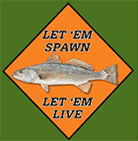Adult Red Drum Tag Retention
SCDNR has employed longline gear to monitor adult red drum in South Carolina since 1994, with tagging occurring since 2001 and genetic tissue sampling (fin clips) since 2003. Tag-recapture studies have long been used to look at fish movement and to make estimates of abundance and mortality/survival. For example, if you know how many fish have been previously tagged in a given area, you can estimate the population in that area by determining the ratio of tagged fish to non-tagged fish you recapture. The more tagged fish you recapture, the smaller the population is estimated to be as this suggests that the fish you tagged account for a higher percentage of the overall population. However, tag loss can result in an overestimation of the population and bias the results of a tag-recapture study. To account for tag loss and correct these potential biases, a long-term study was conducted to determine tag retention rates of several different types of tags deployed in red drum adults.
Four different types of fish tags were evaluated in the study; microsatellite genetic tags, implanted passive integrated transponder (PIT) tags, and two external dart tags; nylon and stainless steel (fig. 1). A total of 1,986 fish were sampled as part of an adult red drum survey in South Carolina. Upon capture, each fish was fitted with all three of the physical tags (2 darts, 1 PIT) and a fin clip was taken before release back into the wild. Genetic tags, which are permanent and can be used to identify individuals, were used to evaluate long-term PIT tag and dart tag retention in at-large fish over an eight-year period. Retention rates were also compared between the two external tag types in wild and tank-held fish to contrast tag performance in natural and controlled conditions.

PIT tags showed 100% retention throughout this study, and were retained for 2048 days in the wild. However, external tag retention in wild fish decreased significantly over time with nylon dart tags being retained for about one year longer than stainless steel dart tags in fish at-large. Both external tags exhibited chronic loss and were unlikely to be retained in wild fish after two or three years. Conversely, external tag retention in tank-held fish remained high over the duration of the study and nylon dart tags were retained significantly longer in tank-held fish than in wild fish. Therefore, retention rates from controlled tank-held fish are not directly applicable to field studies.
All four types of tags have advantages and disadvantages that make them appropriate for certain types of scientific studies. PIT tags demonstrated permanence as they have in other studies, but are not readily apparent to non-project personnel and require an expensive pit tag reader to be identified. Genetic tags were found to be very efficient individual fish identifiers. This type of tag cannot be shed, but it requires the ability to genotype samples in order to be useful. Both types of external tags are less expensive and because they are readily apparent to recreational anglers, they are an effective way to collect information from non-project personnel. However, as the study results indicate, they exhibit low long-term retention rates. Our study represents the most complete tag retention study conducted on adult red drum along the Southeastern United States. Results suggest that nylon dart tags could be helpful for short-term studies to assess movement and as a way to include recreational fishing information, since tag detection is immediate and does not require special equipment. However, genetic tagging and PIT tagging are both more appropriate and recommended for long-term field studies.



